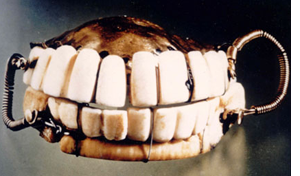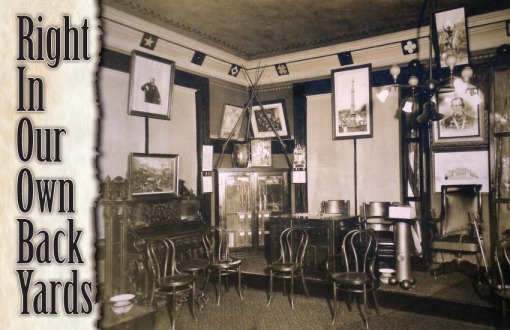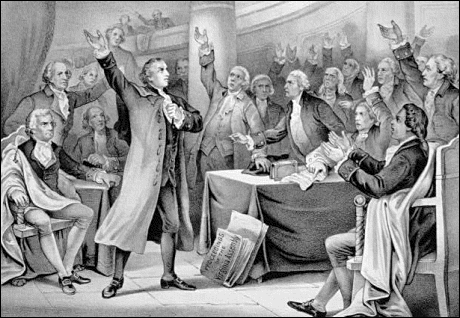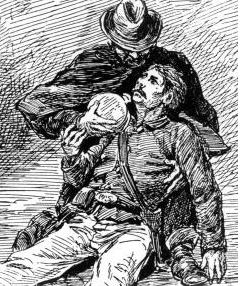Continental Cavities
 It is no secret that the father of our country was cursed throughout his life with major dental problems. Most people however are not aware just how bad George Washington’s teeth were.
It is no secret that the father of our country was cursed throughout his life with major dental problems. Most people however are not aware just how bad George Washington’s teeth were.
To put it in perspective, Washington lost about 1 adult tooth per year from the age of 24 on. By the time he was inaugurated as president in 1789, he had but one tooth left in his mouth, a lower left bicuspid. Surprisingly, these issues were not due to poor hygiene as Washington made great efforts to combat tooth decay by using cleansers, scalers and powders. None of these treatments worked.
Over the years, Washington wore several sets of false teeth made from everything but wood including elephant and hippopotamus ivory, walrus tusk, and even the teeth of a fellow human. These hand crafted dentures were considered to be state-of-the art at the time, but woefully primitive in retrospect. According to Barbara Glover, author of George Washington - A Dental Victim, “Washington often returned dentures for adjustments and repairs, at one time complaining that ‘they were forcing his lips out.’” She added that, “It is not difficult to imagine that George Washington's dental problems might have had some influence on history. Dental discomfort is said to have caused him to forgo giving his second inaugural address.”
Ron Chernow, author of Washington: A Life states, “If Washington was self conscious about smiling in later years, it may have also been because his dentures grew discolored…In December 1798, the dentist noted that they had turned ‘very black,’ either because Washington had soaked them in port wine or because he drank too much of it…For someone who took inordinate pride in his appearance, the highly visible dentures must have been mortifying, especially since public speaking and socializing were constant, obligatory duties for a president.”
This unfortunate and embarrassing aspect of Washington’s life was common knowledge at the time and has never been shied away from when examining his legacy. In the museum at Mount Vernon, there is a display case holding a set of the president’s dentures (pictured above). The signage above it presents the following:
At home all day-not well. Still indisposed with an aching tooth and swelled and inflamed gum. - George Washington
Although he was a man of exceptional physical stature and stamina, George Washington suffered from chronically bad teeth. Despite frequent brushing and availing himself of the finest dental care, he suffered through a lifetime of inflamed gums and abscessed teeth. His torturous, oversized dentures left his mouth puffy, raw, and swollen-giving him little reason to smile.
Pittsburgh Movie Premiere Caps Full Day of Civil War Programming At Carnegie Carnegie

For immediate release
Contact Maggie Forbes
412/276-3456, x.6
www.carnegiecarnegie.com
BUY TICKETS ONLINE HERE
The Andrew Carnegie Free Library & Music Hall is rolling out the figurative red carpet for a Pittsburgh movie premiere on Saturday, November 27th. “The Angel of Marye’s Heights,” tells the compelling story of Richard Rowland Kirkland, a Confederate soldier who gave succor to the enemy – Union wounded and dying in the devastating wake of the Battle of Fredericksburg.
The documentary will be introduced by Michael Aubrecht, one of the film’s writers and producers. Though he lives in Fredericksburg now, Aubrecht was born and raised in Green Tree.
The film, and the full day of programming that precedes its premiere, is intended to put the spotlight on the Library & Music Hall’s rare Civil War room: the Captain Thomas Espy Post No. 153 of the Grand Army of the Republic.
The Espy Post has been documented by scholars as probably the most intact GAR post in the country. Civil War veterans met from 1906 until the 1930s in a second floor room of the Library that they custom-furnished as “Memorial Hall.”
Locked away and forgotten for nearly 50 years, the Espy Post was painstakingly restored and re-opened last February, on the 201st anniversary of Abraham Lincoln’s birth. The ACFL&MH has been amazed and gratified by the response to the room’s restoration. The story made national news and visitors have come from far and wide to see it.
“On a single day this summer, visitors came from Austin, TX; Wisconsin; Albany, NY; New Jersey; Oil City and Florida,” enthuses ACFL&MH executive director Maggie Forbes. “The Espy Post is unequivocally a national treasure.”
However, Forbes and library director Diane Klinefelter frequently run into people from Carnegie, Scott, Mt. Lebanon, Bridgeville – throughout the Greater Pittsburgh area – who are either unaware of the Post, or who have yet to visit. “We want to give people a reason to visit now,” explains Klinefelter.
“Right in Our Own Back Yards” is a full day of programming designed to do just that. The ACFL&MH is offering not only expanded tours of the Espy Post, but behind the scenes tours of its entire historic landmark facility on Thanksgiving Saturday from 11:00 a.m. until 4:00 p.m. The day’s programming is made possible through the support of Northwest Savings Bank.
“On Thursday people eat; on Friday people shop; on Saturday they are looking for something to do with out of town family and friends. We want them to come here!” says Forbes. The Espy Post guest book shows that the Espy Post attracts a national audience. However, the whole building is historically rich and architecturally significant. On November 27, the ACFL&MH will take people into the Music Hall, backstage, into the dressing rooms, into the old gymnasium.
The Library & Music Hall had already planned this special day of Civil War-based programming when filmmaker Michael Aubrecht contacted Ms. Forbes, looking for a venue to show “The Angel of Marye’s Heights.”
“The Angel of Marye’s Heights” goes well beyond the story of a young Confederate infantry sergeant from South Carolina. It also documents the courage and tenacity of the Federal troops who participated in the doomed assault at the Battle of Fredericksburg. Some of these men were volunteers from Pittsburgh who may have very well shared Richard Kirkland’s canteen.
Michael Aubrecht explains how this story has gone full circle. “If you climb to the top of Marye’s Heights today you will find the Fredericksburg National Cemetery. In the center stands the Pennsylvania Monument which pays tribute to the 123rd PA Regiment Volunteers who were mustered out of Allegheny County.” He appreciates the connections with the Espy Post. “As this statue keeps the memory of these men alive, so too does the Espy Post. Ironically,” adds the Green Tree native, “the Andrew Carnegie Free Library & Music Hall is ‘in my own backyard.’ What better place to share this remarkable story?”
“The Angel of Marye’s Heights” will be shown at 7:30 p.m. A dessert reception follows the half hour documentary, along with conversation with Mr. Aubrecht and tours of the Espy Post.
Tours of the Espy Post and Andrew Carnegie Free Library & Music Hall are free and open to the public from 11:00 a.m. to 4:00 p.m. The ACFL&MH is also showcasing photographs of the Library & Music Hall and of Carnegie itself by artist Bernadette Kazmarski [who designed this event's promo postcard.] Light refreshments and Carnegie Carnegie merchandise will be on sale.
Tickets to “The Angel of Marye’s Heights” and the dessert reception are $10. Tickets are available at the Library circulation desk or at www.carnegiecarnegie.org.
For more information on “The Angel of Marye’s Heights” visit www.theangelmovie.com. Michael Aubrecht may be reached at stlrsfan1@aol.com.
Forgotten Founders

ABOVE: 1876 Currier and Ives lithograph of Patrick Henry
Last night I heard a talk-radio host state that the majority of citizens in the United States cannot name more than a dozen Founding Fathers. I agreed with him and could only come up with 18 names myself. There is some debate over exactly how many of our Nation’s principle founders qualify for the title of “Father,” but I have compiled a list that includes the signers of the Declaration of Independence, signers of the Articles of Confederation and signers of the U.S. Constitution. I then added a list of other political contributors worthy of mention. (Note: many names are repeated)
When examining the list I am amazed at how many names I am not familiar with. It also struck me that I could name the starting line-up of most of my favorite baseball teams (by season), yet I have no clue who half these guys are. It goes to show how we prioritize information and how limiting our teaching to a few “marquee” names can drastically narrow our historical knowledge.
I invite you to join me in exploring the lives of the forgotten founders. I plan on picking 10 ‘foreign’ names to investigate. I will share my findings by writing mini-bios in a future post. As enamored as I am with the Franklins, Adams, and Jeffersons of the group, I feel an obligation, not just as a historian, but as a citizen, to learn something about their overlooked peers.
The Signers of the Declaration of Independence
Massachusetts: John Hancock, Samuel Adams, John Adams, Robert Treat Paine, Elbridge Gerry
New Hampshire: Josiah Bartlett, William Whipple, Matthew Thornton,
Rhode Island: Stephen Hopkins, William Ellery
Connecticut: Roger Sherman, Samuel Huntington, William Williams, Oliver Wolcott
New York: William Floyd, Philip Livingston, Francis Lewis, Lewis Morris
New Jersey: Richard Stockton, John Witherspoon, Francis Hopkinson, John Hart, Abraham Clark
Pennsylvania: Robert Morris, Benjamin Rush, Benjamin Franklin, John Morton, George Clymer, James Smith, George Taylor, James Wilson, George Ross
Delaware: Caesar Rodney, George Read, Thomas M' Kean
Maryland: Samuel Chase, William Paca, Thomas Stone, Charles Carrol
Virginia: George Wythe, Richard Henry Lee, Thomas Jefferson, Benjamin Harrison, Thomas Nelson, Jr., Francis Lightfoot Lee, Carter Braxton
North Carolina: William Hooper, Joseph Hewes, John Penn
South Carolina: Edward Rutledge, Thomas Heyward, Thomas Lynch, Arthur Middleton
Georgia: Button Gwinnett, Lyman Hall, George Walton
The Signers of the Articles of Confederation
New Hampshire: Josiah Bartlett, John Wentworth, Jr.
Massachusetts: John Hancock, Samuel Adams, Elbridge Gerry, Francis Dana, James Lovell, Samuel Holten
Rhode Island: William Ellery, Henry Marchant, John Collins
Connecticut: Roger Sherman, Samuel Huntington, Oliver Wolcott, Titus Hosmer, Andrew Adams
New York: James Duane, Francis Lewis, William Duer, Gouverneur Morris,
New Jersey: John Witherspoon, Nathaniel Scudder
Pennsylvania: Robert Morris, Daniel Roberdeau, Jonathan Bayard Smith, William Clingan, Joseph Reed
Delaware: Thomas McKean, John Dickinson, Nicholas Van Dyke
Maryland: John Hanson, Daniel Carroll
Virginia: Richard Henry Lee, John Banister, Thomas Adams, John Harvie, Francis Lightfoot Lee
North Carolina: John Penn, Cornelius Harnett, John Williams
South Carolina: Henry Laurens, William Henry Drayton, John Mathews, Richard Hutson, Thomas Heyward, Jr.
Georgia: John Walton, Edward Telfair, Edward Langworthy
The Signers of the U. S. Constitution
New Hampshire: John Langdon, Nicholas Gilman
Massachusetts: Rufus King, Nathaniel Gorham
Connecticut: Roger Sherman, William Samuel Johnson
New York: Alexander Hamilton
New Jersey: William Livingston, David Brearley, William Paterson, Jonathan Dayton
Pennsylvania: Benjamin Franklin, Thomas Mifflin, Robert Morris, George Clymer, Thomas FitzSimons, Jared Ingersoll, Gouverneur Morris, James Wilson
Delaware: George Read, Gunning Bedford, Jr., John Dickinson, Richard Bassett, Jacob Broom
Maryland: James McHenry, Daniel Carroll, Dan of St. Thomas Jenifer
Virginia: John Blair, James Madison, Jr., George Washington
North Carolina: William Blount, Richard Dobbs Spaight, Hugh Williamson
South Carolina: John Rutledge, Charles Cotesworth Pinckney, Charles Pinckney, Pierce Butler
Georgia: William Few, Abraham Baldwin
Others of Note
Ethan Allen, Richard Bland, George Clinton, Patrick Henry, John Jay, Henry Knox, Robert Livingston, James Monroe, Thomas Paine, Edmund Randolph, Charles Thomson
Was Richard Kirkland really risking his life for an enemy?
“It’s real easy to think that you would risk your life for a friend, but to risk your life for an enemy is something that is very rare indeed. And that, to me, is the story of Richard Kirkland.”
 I spoke those words as the conclusion to my segment in the documentary “The Angel of Marye’s Heights.” Since then, I’ve quoted it in speeches, panel discussions and radio interviews.
I spoke those words as the conclusion to my segment in the documentary “The Angel of Marye’s Heights.” Since then, I’ve quoted it in speeches, panel discussions and radio interviews.
This is the essence of Richard Kirkland’s remarkable act and it has left an indelible impression on me. Over the last few months our team has screened this film in theaters, museums and universities. No matter what venue, the message that seems to be resonating with people is “be kind to your enemy.”
This is a difficult, if not impossible virtue to grasp. It does become more palatable however, if we re-examine the use of the term “enemy.” Were these men truly enemies and does Kirkland’s reaction to the suffering of his foes nullify the very meaning of the word when used in the context of the War Between the States? After all, just days before the onset of war, these men were citizens under the same flag, with the same God, and shared history.
It is impossible not to feel sympathy for the suffering that existed between both armies on the field at Fredericksburg. Far too often we have focused on the battle strictly in a political or tactical sense. We simply recognize both armies separately, as bitter rivals hell-bent on each other’s destruction. This is true to a point, but we cannot forget that these adversaries shared a collective existence together as countrymen, and were only enemies under their own self-inflicted circumstances.
In other words, they brought it on themselves by pursuing a military action that literally pitted brother against brother. This is what makes a “civil war” even more tragic than a traditional conflict between nations. It is also what makes the eleven doomed assaults at the stone wall even more absurd, and Richard Kirkland’s act of mercy comprehensible.
In our film storyteller Megan Hicks notes the conflicting nature of Kirkland’s actions as he was both a killer and a kind, compassionate man. During the engagement, Kirkland shot at the very men who he would later administer aide to. This conflicting-conscience goes both ways. In the same light, could the opposing soldiers on the battlefield simultaneously be Kirkland’s enemy and his countryman?
It opens up a whole new dynamic if you accept that there is no black and white in this story. This paradigm was true for the entire conflict from the first shot at Fort Sumter to the surrender at Appomattox. The line between right and wrong, friend and foe were blurred beyond comparison. Perhaps that is why the Civil War is still furiously debated to this very day.
As we prepare to acknowledge the Civil War Sesquicentennial in 2011, the practice of self-inflicted separation remains. It seems that in today’s society the word enemy is thrown around casually as the “argument itself” has become more important than the subject being argued over. Frankly, I can’t recall any other time in my life that our country’s division has been so rampant and spiteful.
We live in a nation of blue and red states and left and right politics. Each night we gather around the television to hear talk show hosts claim that the other’s opposing viewpoints have doomed us all. Americans love to fight amongst ourselves and we are nurturing a culture of enemies. Not much has changed in 150 years.
Perhaps we could learn a lesson from Richard Kirkland and rethink what it truly means to be an “enemy.” Maybe then we can learn to get along.
FEEDBACK: What is your take on this subject? Email your thoughts and I will share them in a future follow-up post.
Posted by ny5/pinstripepress
at 11:25 AM EDT
Updated: Wednesday, 13 October 2010 9:23 AM EDT
Permalink |
Share This Post
 It is no secret that the father of our country was cursed throughout his life with major dental problems. Most people however are not aware just how bad George Washington’s teeth were.
It is no secret that the father of our country was cursed throughout his life with major dental problems. Most people however are not aware just how bad George Washington’s teeth were. 







 I spoke those words as the conclusion to my segment in the documentary “The Angel of Marye’s Heights.” Since then, I’ve quoted it in speeches, panel discussions and radio interviews.
I spoke those words as the conclusion to my segment in the documentary “The Angel of Marye’s Heights.” Since then, I’ve quoted it in speeches, panel discussions and radio interviews.